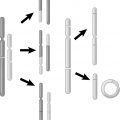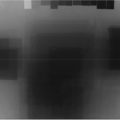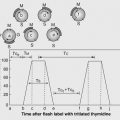8
ASSAYS FOR CELL, TISSUE, AND SOLID TUMORS
C. MARC LEYRER, EHSAN H. BALAGAMWALA, AND CAMILLE BERRIOCHOA
Question 1
What is a vector?
Question 2
What are the different types of vectors?
Question 3
What is the difference between an adenovirus and a retrovirus?
Question 4
What is the purpose of agarose gel electrophoresis, and which charge does the DNA move toward?
Question 1 What is a vector?
Answer 1
A vector is a self-replicating DNA molecule, which artificially carries a foreign DNA into a host cell where it can be replicated and/or expressed.
Hall EJ, Giaccia AJ. Molecular techniques in radiobiology. In: Hall EJ, Giaccia AJ, eds. Radiobiology for the Radiologist. 6th ed. Philadelphia, PA: Lippincott Williams & Wilkins; 2006:240–273.
Question 2 What are the different types of vectors?
Answer 2
a. Plasmid—circular DNA molecules that can contain a piece of foreign DNA, which can reside and replicate inside bacteria independent of the host chromosome. Limited to small DNA inserts up to 10,000 base pairs (bp).
b. Bacteriophage—a virus that infects and replicates within bacteria with the central portion deleted and foreign DNA inserted. Can accommodate larger DNA fragments than plasmids, up to 24,000 bp.
c. Bacterial artificial chromosomes (BACs)—a DNA construct used for transforming and cloning in bacteria (usually Escherichia coli) with large DNA fragments up to 300,000 bp.
d. Viruses—most efficient vector for gene transfer and similar to how a bacteriophage integrates DNA into a bacteria but also effective in mammalian cells. Generally, genetically engineered viruses integrate noninfectious viral DNA (adenovirus) or RNA (retrovirus).
Brown TA. Vectors for gene cloning: plasmids and bacteriophage (chap 2). In: Brown TA, ed. Gene Cloning and DNA Analysis: An Introduction. 6th ed. Oxford/Hoboken, NJ: Wiley-Blackwell; 2010:14–27.
Hall EJ, Giaccia AJ. Molecular techniques in radiobiology. In: Hall EJ, Giaccia AJ, eds. Radiobiology for the Radiologist. 6th ed. Philadelphia, PA: Lippincott Williams & Wilkins; 2006:240–273.
Question 3 What is the difference between an adenovirus and a retrovirus?
Answer 3
Retroviruses integrate the viral RNA into the DNA by reverse transcription to DNA, which is then integrated to the host DNA through an integrase enzyme. This method requires active division of the host cell for replication. An adenovirus contains double-stranded DNA, which is not integrated into the host DNA. It instead uses the host cell’s enzymes and proteins for replication.
Brown TA. Vectors for gene cloning: plasmids and bacteriophage. In: Brown TA, ed. Gene Cloning and DNA Analysis: An Introduction. 6th ed. Wiley-Blackwell; 2010:14–27.
Hall EJ, Giaccia AJ. Molecular techniques in radiobiology. In: Hall EJ, Giaccia AJ, eds. Radiobiology for the Radiologist. 6th ed. Philadelphia, PA: Lippincott Williams & Wilkins; 2006:240–273.
Question 4 What is the purpose of agarose gel electrophoresis, and which charge does the DNA move toward?
Answer 4
It allows the separation of multiple differing DNA fragments based on the size when under a constant charge. It takes advantage of the negative charge on DNA, which moves from the negative pole toward the positive pole at a rate that is dependent on the size of the DNA.
Hall EJ, Giaccia AJ. Molecular techniques in radiobiology. In: Hall EJ, Giaccia AJ, eds. Radiobiology for the Radiologist. 6th ed. Philadelphia, PA: Lippincott Williams & Wilkins; 2006:240–273.
Question 5
What is the process of polymerase chain reactions (PCR)?
Question 6
What is an exonuclease?
Question 7
What is an endonuclease?
Question 8
What are restriction endonucleases?
Question 5 What is the process of polymerase chain reactions (PCR)?
Answer 5
a. Identify the section of dsDNA sequence requiring amplification and create a primer corresponding to the 5′ end of the dsDNA.
b. Combine the two primers and the DNA sample to be amplified with a heat-stable Taq DNA polymerase and an excess amount of the four deoxyribonucleotide triphosphates.
c. Heat the sample to 94°C to denature the dsDNA.
d. Cool to ~50°C to allow the primers to anneal to the complementary sequence on the DNA.
e. Heat the sample to 72°C, which is the optimal temperature for the Taq polymerase to allow for extension from the primers along the DNA strand, creating a new dsDNA.
f. This process is repeated 25 to 35 times to create millions of copies of a specific DNA fragment.
Hall EJ, Giaccia AJ. Molecular techniques in radiobiology. In: Hall EJ, Giaccia AJ, eds. Radiobiology for the Radiologist. 6th ed. Philadelphia, PA: Lippincott Williams & Wilkins; 2006:240–273.
Question 6 What is an exonuclease?
Answer 6
An exonuclease is an enzyme that cleaves nucleotides at one end of a polynucleotide chain by hydrolysis, which breaks phosphodiester bonds at the 3′ or 5′ position.
Hall EJ, Giaccia AJ. Molecular techniques in radiobiology. In: Hall EJ, Giaccia AJ, eds. Radiobiology for the Radiologist. 6th ed. Philadelphia, PA: Lippincott Williams & Wilkins; 2006:240–273.
Question 7 What is an endonuclease?
Answer 7
An endonuclease is an enzyme that cleaves the phosphodiester bonds in the middle of a polynucleotide chain.
Hall EJ, Giaccia AJ. Molecular techniques in radiobiology. In: Hall EJ, Giaccia AJ, eds. Radiobiology for the Radiologist. 6th ed. Philadelphia, PA: Lippincott Williams & Wilkins; 2006:240–273.
Question 8 What are restriction endonucleases?
Answer 8
This endonuclease cleaves at or near a specific DNA sequence. This is usually a short 4 to 8 nucleotide site and usually a palindromic sequence. A palindromic sequence is one which is read the same way if evaluated in either direction along the DNA.
Hall EJ, Giaccia AJ. Molecular techniques in radiobiology. In: Hall EJ, Giaccia AJ, eds. Radiobiology for the Radiologist. 6th ed. Philadelphia, PA: Lippincott Williams & Wilkins; 2006:240–273.
Question 9
What is the difference between a Southern, Northern, and Western blot?
Question 10
What is chromosome walking?
Question 11
What is homologous recombination and how is it utilized in genomic analysis?







